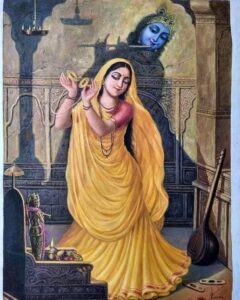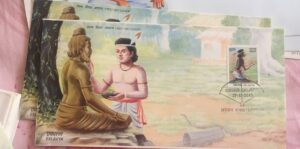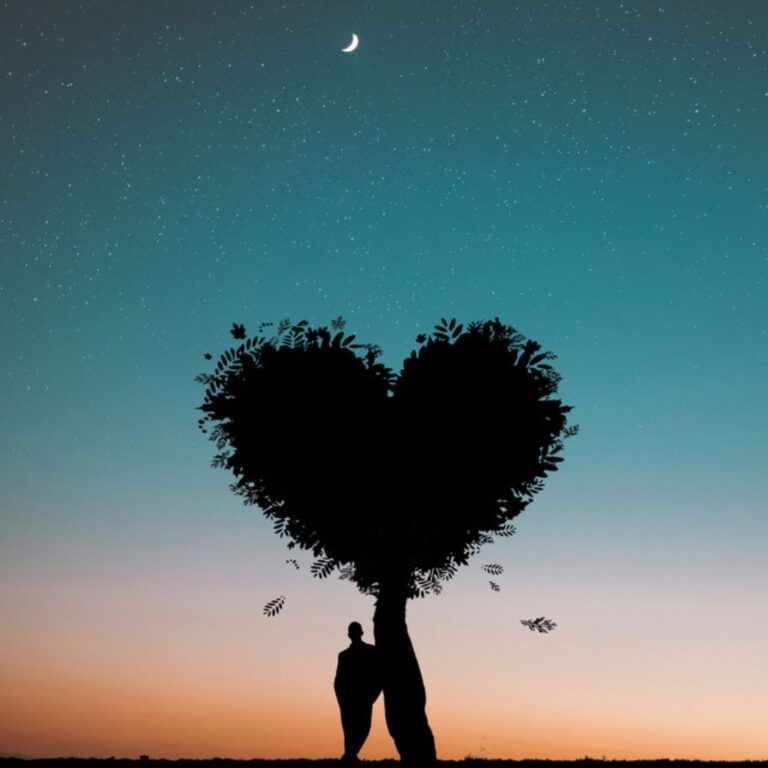Written by: Akshika Jangid
Long before when ink touched paper and screens came to life, storytelling was a living, breathing art passed from mouth to ear, generation to generation. It was through these spoken words that ancient voices found immortality, weaving tales infused with human dreams, fears, and wisdom. Orality was not merely a means of communication but the heartbeat of culture, binding communities through shared memory and experience.
In this continuity of voice, from ancient Indian caves to modern means of communication, the essence of storytelling reveals why some stories persist, echoing across generations. It carries universal emotions and values, evolving in form while preserving their core essence. In India, the transition from oral storytelling to written and printed texts mirrors humanity’s journey through time, with legendary narratives—mythic, historical, and modern—retaining their relevance and power.
The ancient Indian tradition of orality was foundational: epics like the Ramayana and Mahabharata, folk tales such as Panchatantra, and regional legends were passed down verbally long before writing emerged. Oral storytelling forged bonds, instilled values, and connected listeners to their cultural heritage, even as societies changed.
The move to written and printed literature preserved these stories for wider audiences and future generations, but did not erase the importance of performance and community engagement.
Indian classical literature has some of the prime examples of how stories span time and style. We all must have come across the story of a thirsty crow or the stork and the crab from Panchatantra tales while growing up which taught us valuable life lessons on trust, cleverness, morality, intelligence and worldly wisdom.
Storytelling for me is more than just art as it’s a calling. A reminder that our centuries old poetry and songs carry, transcending social barriers. For instance; very famous Mirabai’s bhajans have survived both as oral tradition and written verse, inspiring spiritual seekers. Even passionate love stories like that of Anarkali- Salim & Bajirao Mastani, rooted in historical myth, are retold across generations through oral performance, theatre, and cinema.
Stories as Tools for Change
Stories have the power to shape our understanding of the world, educate ourselves and transform society for the better by instigating us to question our values, examine social norms and imagine new possibilities. The films like Dead Poets Society are a profound call to action for the young generation to ‘Seize the day’ and pursue our passions. Stories also survive because they adapt and reinvent themselves across time and culture. A good example of this is the Bollywood movie Mohabbatein, reimagining a tale of personal expression, authority, and the courage to live by one’s values in an Indian context.
In Dead Poets Society, we see Mr. Keating encouraging his students to find their own voices through poetry, while in Mohabbatein, Raj Aryan inspires students to embrace love and emotional freedom within the rigid discipline of Gurukul.
What makes this adaptation unique is its universality. By blending global storytelling motifs with local emotions, language, culture, and values, films like Mohabbatein ensure that stories remain alive, meaningful, and relatable for new generations of audiences.
The Universal Language of Storytelling
No matter where we come from, stories remind us that our differences are small compared to what connects us. Modern Indian Cinema has consistently tried to draw inspiration from stories from the past to explore modern day dilemmas. The story of Eklavya is reflected in many discourse and art forms as how merit, equality and social justice plays an important role in society. This can also be seen in films like Slumdog Millionaire, which became a global hit not because audiences everywhere had faced the same hardships as the protagonist, but because it struck a deeper chord—hope, resilience, love, and the belief in destiny—resonate universally. Jamal’s journey is the ultimate underdog story, where his life experiences, though brutal, coincidentally provide the “merit” (knowledge) he needs to succeed.
Both stories of Jamal and Eklavya unanimously celebrate the idea that talent, knowledge, and inner strength can defy stacked odds and predetermined destinies.
Stories from the mythology
If I sit thinking about one tale from Indian mythology that is still relevant even today, then I would be confronted with a choice dilemma about which one to pick because Indian mythology is brimming with stories that have been passed down to us through ages. To mention a few, there is story of Krishna befriending Sudama, how Hanuman mistook Sun as a fruit only to have learnt the lesson of not acting impulsively, one where Skanda taught us to to become a strong leader, and last but not the least the story of the curse of brahmins given to the King Vasu for killing a cow. These stories are timeless wisdom and insights on friendship, vulnerability, leadership, compassion and forgiveness.
The reason why I am so fascinated by mythological stories over movies is because the end of these stories are not overhyped and celebrated for a single, predictable theme like “the victory of good over evil.” Unlike many movies, these epics reveal how good characters also have to make a lot of sacrifices and instead of a one-sided triumph, we learn the connection between the good and bad within the tales from the epic. This depth allows us to appreciate the shared journey of both good and bad, making their lessons feel richer and more meaningful.
I remember one such story that is based on this similar theme is when Lord Vishnu takes the form of Mohini to outwit Vrikasur. So the story begins at a time when Vrikasur was an ardent devotee of Lord Shiva, who went through severe penance and won Lord Shiva’s rare boon: the power that anyone’s head he touched would turn into ashes.
Thrilled by his new powers, Vrikasur soon came to be known as Bhasmasura, who eventually lost his control and tried to destroy Shiva to test his strength. As Shiva fled in desperation, Lord Vishnu stepped in and cleverly tricked Bhasmasura into his own undoing i.e. by making him place his own hand on his head. 
Now you would ask , why did Vishnu choose to erase the source of his empowerment?
Well the story isn’t about outwitting anyone; it’s a profound tale that warns you that ambition without empathy can be dangerous. The lesson that I learnt is that despite Bhasmasura’s relentless ambition and devotion, his pursuit of power, without a moral judgement, made him a threat to everyone, even his followers. Just like a boss who misuses authority and harms teamwork, this story points out that real greatness isn’t just about achievement, but about using power wisely and helping others.
Way forward- A call for wisdom, kindness and owning OUR responsibility
Stories with some elements of surprise and strong themes we all recognize—love, loss, hope, betrayal, resilience, or the search for meaning, ignite the reader’s imagination. What gives these stories their enduring life is not a neat resolution of every question but the opposite: leaving certain mysteries untouched, like fear that continues to glow in the reader’s mind. It does not mean that it needs to resolve everything; sometimes the unanswered parts are what stay with us. When puzzles remain, they invite readers to shape their own meaning and reflect on their own lives. That lingering uncertainty is often what allows the story to last longer.







